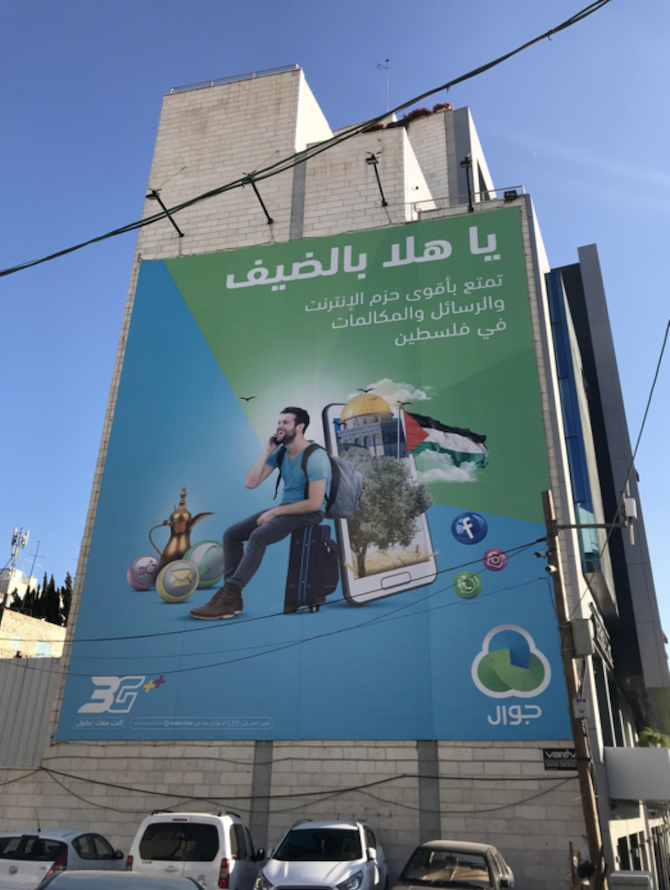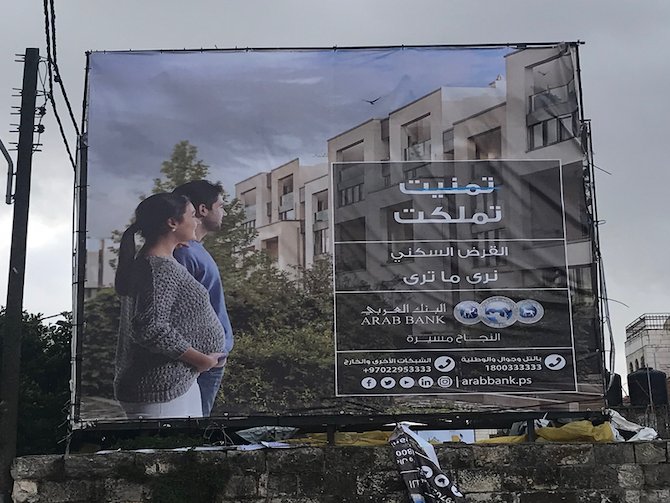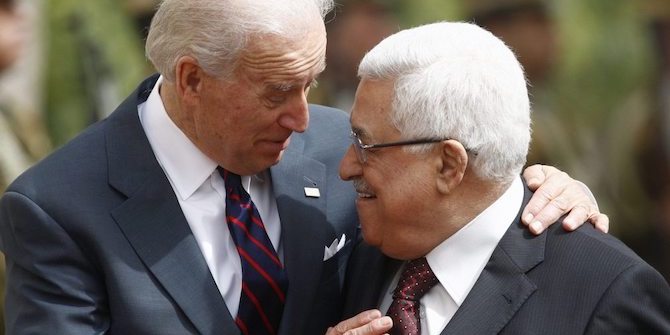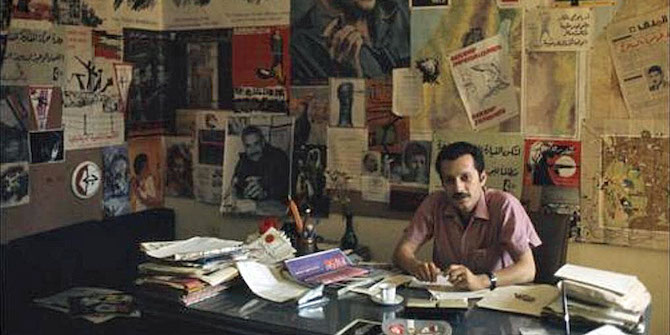by Polly Withers

Scope & Themes: Selling the Nation?
A Palestinian flag, an olive tree, and Jerusalem’s iconic Dome of the Rock mosque. Three icons at the heart of Palestinian resistance and its visual mediation. These three national metonyms are similarly central in this billboard advertisement (Figure 1), blazoned above a car park in downtown Ramallah in summer 2018. Here, however, they do not perform the Palestinian nation, Palestinian nationalism, or cultural politics. Instead, they are themes through which a mobile phone company (Jawwal) brands a particular product (line rental) to an imagined future client. In this advert, then, historic national iconography is articulated to capitalist marketing culture, and the political project of liberating Palestine catapulted into a bygone era – useful only insofar as it might prompt people to select this commodity rather than another, from an ever-swelling consumer marketplace.
Except that Palestine has not been liberated, and the Palestinians remain subject to the brutalities of Israeli settler-colonial domination. In the militarily occupied West Bank, where this research is located, people live in a colonial present under neoliberal capitalism cultivated through Oslo’s disastrous failings. Given that the struggle for national emancipation is far from settled in occupied Palestine, why has capitalist culture been able to incorporate resistance symbols and national markers into its advertising techniques? What can this uncanny alliance between cultures of resistance and expressions of consumption tell us about political identities and social change in the contemporary West Bank?

This Middle East Centre collaboration project with Birzeit University is anchored around such questions. In today’s Ramallah, the ‘unofficial’ capital of the Israeli-occupied Palestinian West Bank, many such commercial advertisements scramble to dominate the city’s skylines. They frequently index collisions between local cultural idioms from the past with global financial structures in the present. Often companies deploy bright glossy images of young nuclear families – always a man and a woman, often with light skin – to advertise luxury items, or loans to facilitate their purchase (see Figure 2). Cars, mobile phones, ‘modern’ houses, and lavish weddings mapped to distinctively Palestinian backdrops dominate this pictorial landscape. In this research, I examine how such visual cultures enfold capital, aspiration and enterprise culture into everyday life in contemporary Palestine.
Rationale: Situating Neoliberal Enterprise Culture in Palestine
This study builds on observations gathered while generating data for my PhD research and forthcoming monograph on popular culture in Palestine and its diaspora. As others have noted, until about ten years ago Middle East studies largely overlooked the culture/politics nexus. Instead, social scientists applied nation-state and/or Marxist political economic lenses to study regional politics and social change. State-building, voting patterns, and civil society were all central arenas of investigation in this literature. Today, and in part because of the celebratory scholarship that exploded following the 2010–13 uprisings, academic and popular presses are awash with studies on cultural production. However, despite this surge in debates on music, art, theatre and film, commentary on commercial culture in general and advertisements in particular remains peculiarly absent.
This is surprising. First, because audiences and producers create, circulate, and receive such visual materials widely across the Middle East and North Africa. Second, we know from work on advertising in liberal democracies that when cultural practices create images, they reflect and further social inclusions and exclusions. By recycling stereotypical gender roles to advertise different products to differently imagined consumers, advertisements often reinforce narrow worldviews about femininity and masculinity. Classic media and communications research shows, for instance, that (white and upper-class) men typically have active roles in commercials. Women, on the other hand – and particularly thin, white, and conventionally attractive women – appear either as ‘sex’ symbols that sell cars, or heterosexual housewives who consume domestic homewares and beauty products. Building on such debates, recent theorisations argue that contemporary adverts hollow out feminist slogans (e.g. Dove’s ‘real beauty’ campaign, Nike’s ‘what are girls made of’ and – significantly rendered in Arabic – the same company’s ‘what will they say about you’) to market products to young women. In these commercials, however, feminist ideas do not challenge patriarchal systems. Instead, they ‘empower’ (some) young women to engage in individualised monetised consumption, while cultivating a ‘progressive’ image for the brand.
Advertising cultures similarly communicate powerful norms about gender, sexuality, race, and class to their viewers in the Middle East. In the example above (Figure 2), for instance, we see a young, heterosexual, and light-skinned couple gazing longingly at their ‘dream’ nuclear home. In this project, I address such concerns. Using a mixture of qualitative and audio-visual methods, I ask how the content, production, circulation, and reception of contemporary advertisements in Palestine produce a politics of gender, sexuality, and social relations in the West Bank. How do adverts portray gender, invoke domesticity, and represent emotions like ‘love’? In what ways do audiences receive and respond to such messaging? And how does this tie into class or race-based inequalities?
At its core, the research argues that taking commercial culture seriously is important because advertisements tell us many things about Palestine’s uneven encounters with late-modern consumerism. After Oslo, the Palestinian Authority (PA) incorporated neoliberal systems into their West Bank administration. Scholars often focus on how this reshaped the West Bank’s political economy, and/or rerouted the struggle for national liberation. However, wider debates in cultural studies and sociology show that neoliberalism reconfigures social life more generally. Neoliberal rationalities incite individuals to conduct themselves as entrepreneurs. This ideology transforms subjects into self-disciplined and competitive individuals encouraged to reformulate structural critique into self-critique. Rape culture, wage discrimination, and racism become private grievances rather than collective injustices in this environment.
This is deeply gendered. Neoliberal culture predominantly calls on women and girls to practice ‘freedom’ from patriarchy through consumption, which becomes particularly visible with regard to the management of the body and sexuality. Clothes and lifestyles traditionally associated with women’s objectification (high heels, push up bras, the pursuit of thinness) are transformed into sources of female – even feminist – pleasure.
Downplaying the collective nature of gender, race, and class distress, then, in contexts in which neoliberal controls dominate, systemic problems become personal issues only expressible through individual pathology. The neoliberal girl is taught to channel her rage through her body, which itself becomes a site to perform gendered suffering. Physical and mental pain, and at times even death, are the hallmarks of this toxic culture. Eating disorders, depression, anxiety, self-harm, and suicide are commonplace. Importantly, this is not only psychic. Those who refuse to live life as though it were an enterprise – that is, a business or exercise in entrepreneurship – find themselves rendered ‘lazy’. Their non-conformity is punished materially. Prevented (by racism, classism, misogyny or other structural constraints) from participating in capitalist waged labour, many end up impoverished, homeless, or incarcerated. Neoliberalism, in other words, negatively transforms people’s affective understandings of, and relationships with, themselves and others. It also restricts the material environments and capacities of those who do not or cannot conform to its imperatives. Studying how advertisements cultivate neoliberal enterprise culture is, I argue, crucial to containing its reach.
However, feminist, sociologically grounded research on neoliberalism in the English language often charts Euro-American contexts. As other critical media and communications scholars have pointed, when global north-focused scholars do comment on girls in the global south, they sometimes assume economic disparities do not cross-cut these social groups. Homogenising the global girl, then, this literature might have less to say about the ways that class shapes gendered identities and their representation in Middle East cultures of consumption. Further research is therefore required to understand the extent to which commercial culture impacts communities in the region. In Israeli-dominated Palestine, neoliberal controls are emergent rather than entrenched. Given that the West Bank shift towards a consumer society is still in its infancy, how far does the ‘psychic life of neoliberalism’ penetrate social, emotional, and material contexts for young men and women in Palestine? Does gendered enterprise culture enhance pre-existing class scaffolds, or constitute new hierarchies with novel cultural capitals?
Asking such questions is pertinent for two reasons. First, it adds insight into gender and sexuality in commercial culture in MENA. This nuances debates in the global north, while also filling gaps in Palestine-focused media and communications scholarship. Second, it hopes to contribute to feminists’ and young people’s efforts in the region and beyond to theorise – in order to resignify – the pernicious ways that power invites all of us to understand our bodies, identities and futures.
This blog post introduces the LSE Academic Collaboration with Arab Universities project, in collaboration with Birzeit University: ‘Neoliberal Visions: Exploring Gendered Adverts and Identities in the Palestinian West Bank’.







1 Comments